Program Creation Video
...
Need help creating your first Program? This video will guide you through the steps to set up a Program.
In the MyRec.com system, programs are the container for activities. Activities are the items that the customers register into.
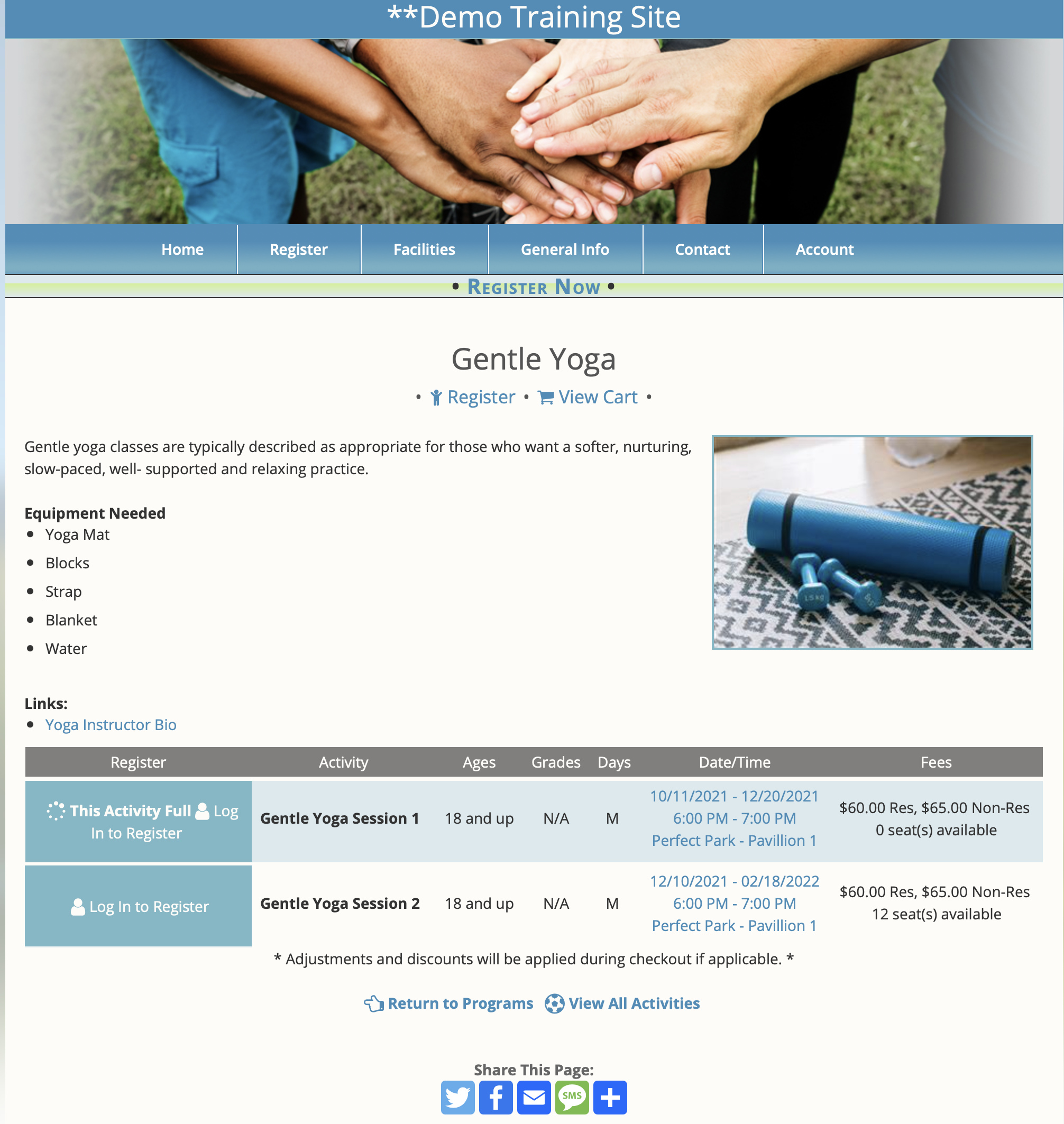
The program title, description, photo, and notes, each detail the activities beneath it. The activities contain the specifics. These specifics include the who (Age, Grade, Residency), the when/where (Dates, Times, Location), as well as the how (how much is it and how many seats are available).
Creating a Program
On the management side of the MyRec.com system, go to the Programs menu, and click Add New Program
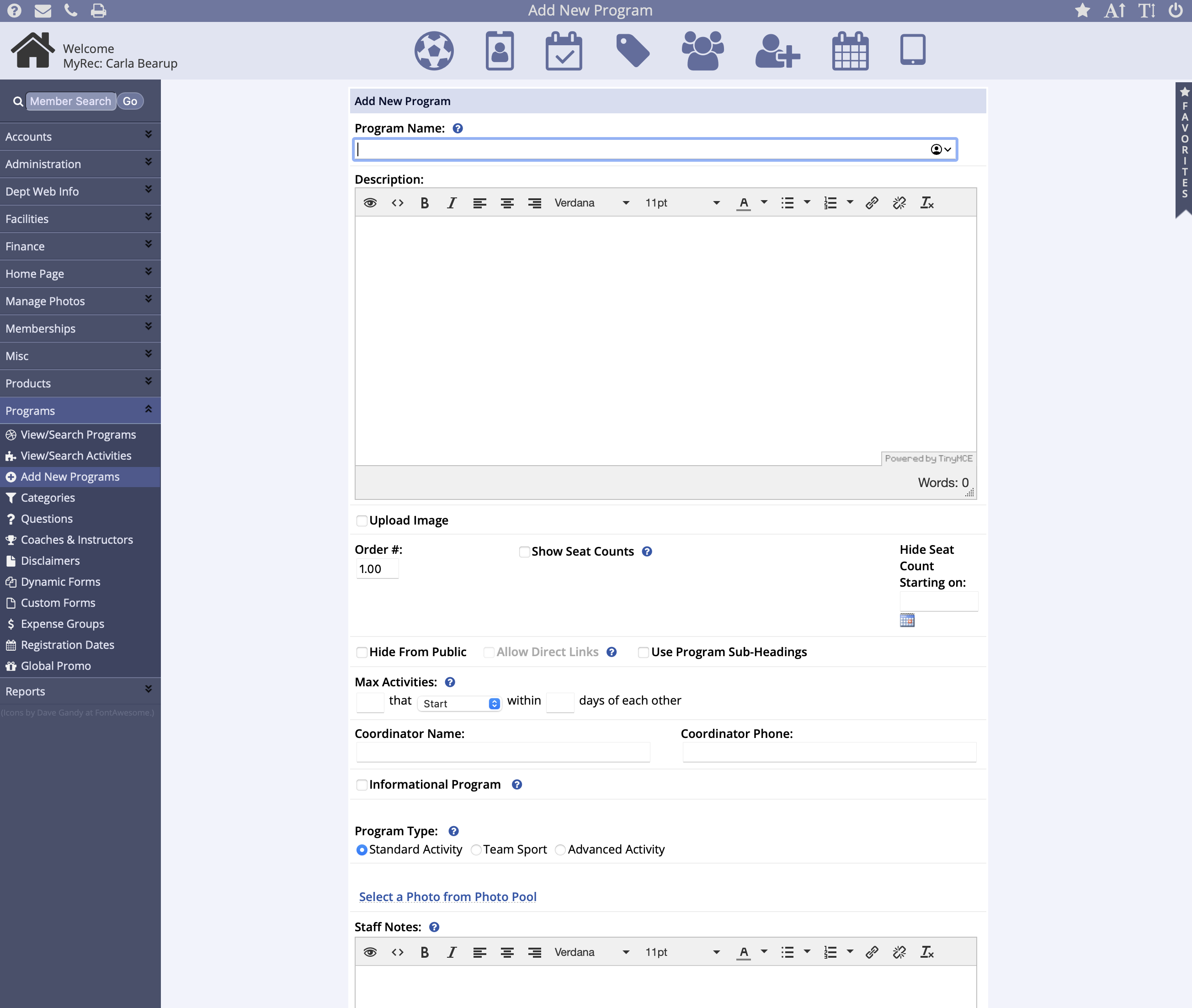
- Name your program and provide a brief description
- At this point, you can use Upload Image to add a photo into the description, or you can choose to use the photo pool, choose a photo by uploading your own or choose from the stock photos
- Next, there are settings on the program level that affect the activities within the program
- One of those settings is to show seat counts
- If this is selected, it allows the real time seat count on all the activities within the program to be viewed on the public side
- If you want this entire program to be hidden from the public side, including all of its activities, check the Hide From Public box
- If you choose to Allow Direct Links, select this when the Hide From Public is also checked
- This enables the public to still access the program, but through a direct link that you provide
- If you choose to Allow Direct Links, select this when the Hide From Public is also checked
- Checking Use Program Subheadings allows for a brief description for a group of activities
- An example of a use for this may be a swimming program since where the description is for the overall program, but the subheadings describe the different swim levels in the activity groups
- The setting for maximum activities, allows us to limit a registrant to only register for a set number of activities in this program
- Utilize coordinator name and coordinator phone number to identify the person responsible for the coordination of this program
- This is helpful if the instructor or coordinator is not a member of staff but is the primary contact for questions about the program (i.e. karate instructor for the program your department hosts)
- One of those settings is to show seat counts
- Program type selection refers to whether the activities in this program will be Standard, Team Sport, or Advanced Activities
- Once the selection is made it cannot be changed
- A Standard Activity is the default selection is the most commonly used and allows for a waitlist feature
-
Team Sport is used for league sport activities like soccer or basketball, where a team schedule will be present, but is different from the team options in a Standard Activity as follows:
- This includes the ability to create a round robin game schedule, track scores, and track standings
- It can also be used where dates are vague because of the ability to set soft dates as a schedule
- It allows you to preset the teams and make them registration choices for the public side registration
-
Advanced activities allow the public to select days, weeks, or months, as registration options and/or pricing options for programs such as after school or camp, which could result in a different roster each day
- This program type does not offer the waitlist feature within the system but will allow you to create a manual waitlist activity and transfer registrants as needed
- Once the selection is made it cannot be changed
- Add to staff notes for information that needs to be referenced by staff
- These notes are only visible on the program view page
- Click Next to complete program creation
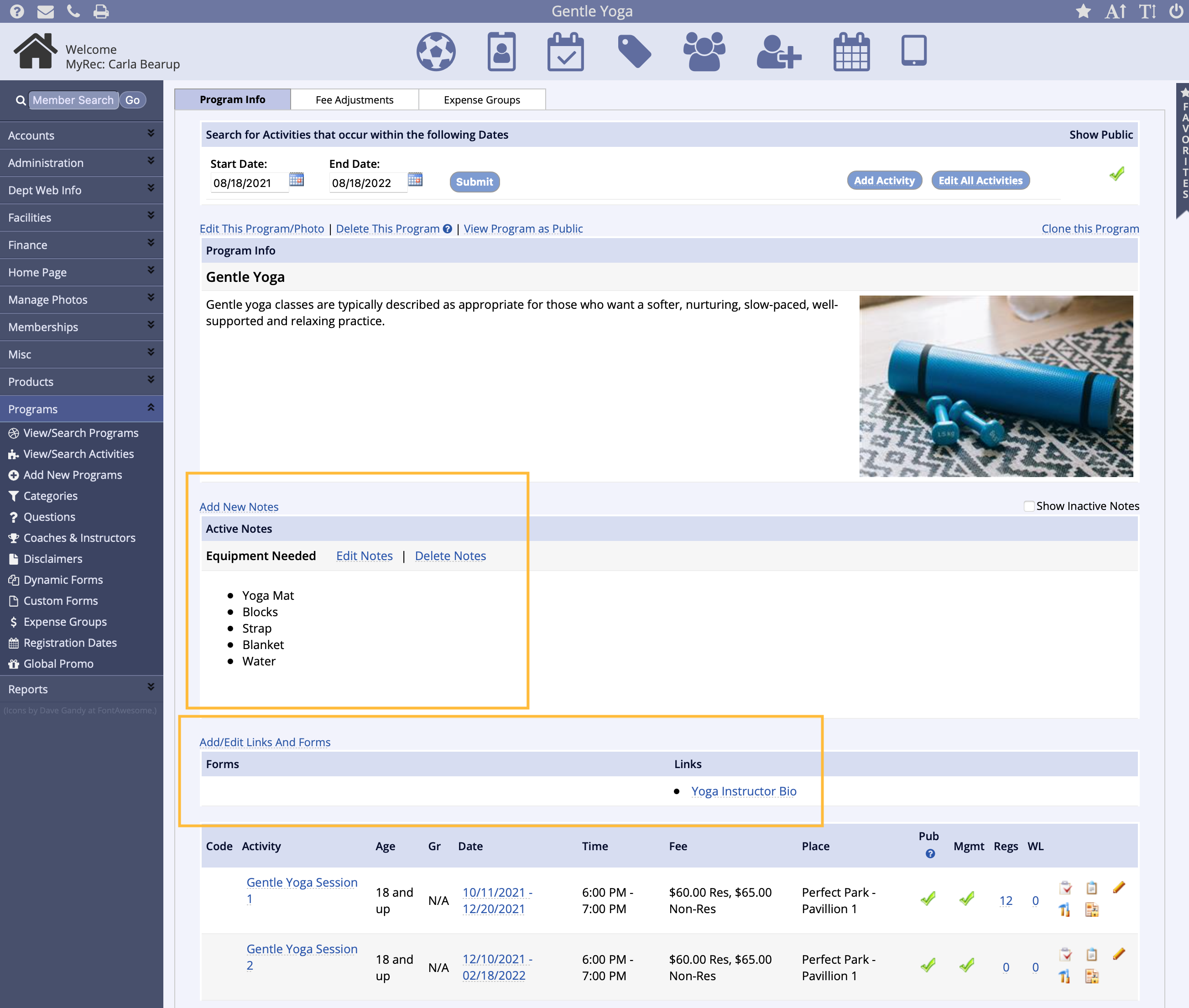
Adding Program Notes
Additional program details can be added and shown on the public side by adding program notes
- Click Add New New Notes
- Give it a title
- Add text
- Click Submit
Additionally, forms and links can also be added to provide the customer with a downloadable form or a link to additional information.
With the program now created, you're able to add activities, please consult the help articles or video guides on activity creation.
Standard Activity Creation
In the MyRec.com system, activities are what your customers will be registering into. Activities populate the calendar and their registrants populate the rosters.
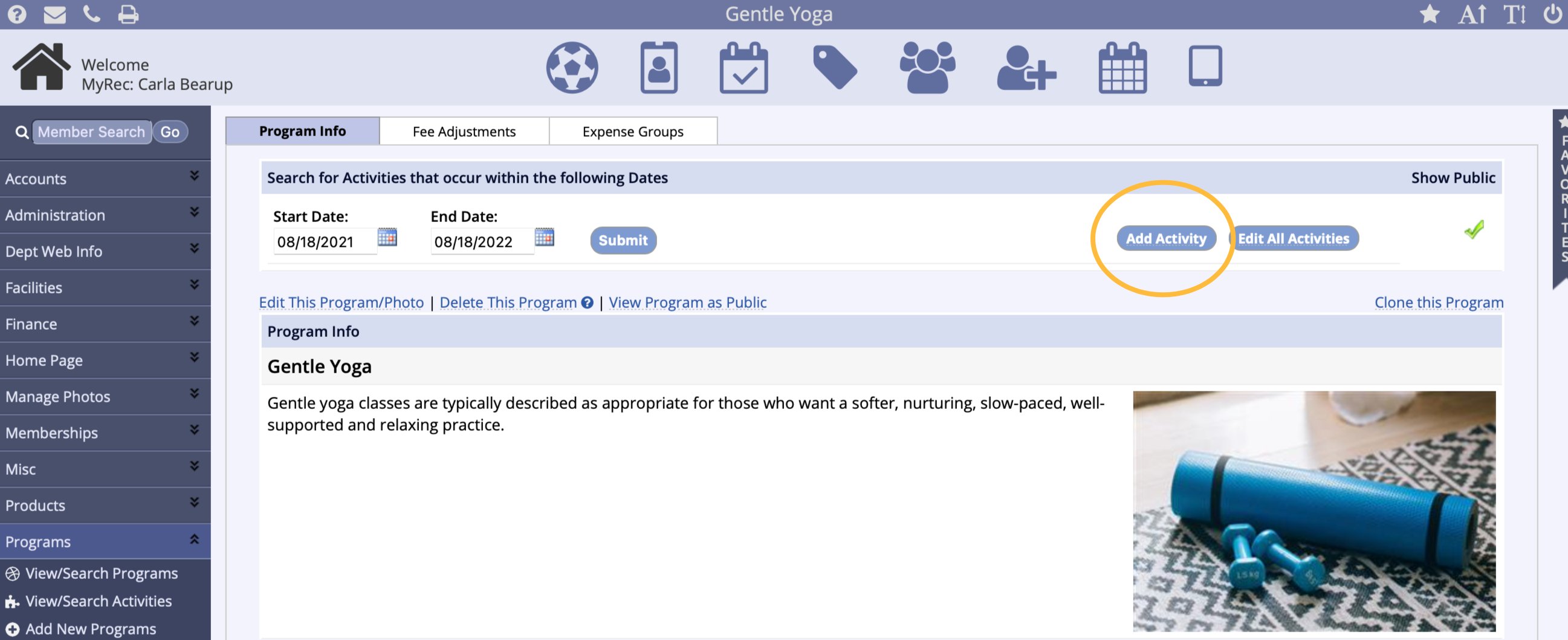
Activities are created within a program. If you add Fee Adjustments at the Program level, they will apply to all activities across the program unless excluded. This is particularly helpful with sibling discounts for children of different ages within separate activities.
Adding a New Activity
- On the program page, click Add New Activity
- Due to the fact that Programs house activities, they must be created first in order to add activities
- See the Program Creation article for more details
- Adding a new activity will take the user through several setup screens, listed below, which will become editable tabs across the top of the page once the activity is saved and added
- Basic Info - set the activity name and category, along with other optional information
- Schedule - set the dates and time along with location of the activity
- Financial Info - assign fees and budget groups to the activity, along with optional expenses and fee adjustments
- Demographic Info - set age, grade, gender, and other demographic restrictions, registration dates, and registration type
- Requirements - apply questions, forms, or required documents for the public
- Confirm and Complete - review settings and submit for completion
Basic Info

- Activity Name - We suggest using a recognizable activity name, such as “yoga flow AM”, instead of “morning class”
- The Activity Code field is used if your department assigns codes to activities
- Activities can be searched on the code for registration
- The Activity Order number shows the order in which the activities are organized on the site, the lower the number, the higher on the list the activity will appear
- Select a Category from the drop down menu or add a new one
- A category is the section this activity will be filed under when viewing all activities from the public side.
- Click View/Add Coaches & Instructors to give access to rosters for this activity, which are viewable on the Coach or Instructor public side accounts
- Activity Notes is a place to enter additional need to know information
- This information shows under the activity for the public prior to registration
- If Receipt Notes are entered, they will appear on the printable and emailed receipt upon the completion of the registration
- Maintenance Notes are a place to enter any setup or staff details that will only appear on the facility maintenance report
- Date to Show on Public Site defines the date this activity is visible to the public
- If it is blank, the activity will appear immediately
- If the second field is blank, the activity will drop off the public side after the last activity date
- Check applicable Hide options
- When Hide This Activity from Public is checked, the public will not be able to view this activity
- When Hide This Activity from Management is checked, the activity will not appear in the activity search results for management side registration
- When Hide from Management Calendar is checked, the activity will not appear on the management calendar
- This is useful is a lot of repetitive activities are filling your staff calendar, like swim lessons
- Next, are several special settings that can be used
- Please see the question mark next to each setting for a description
- Click Next Step to create a schedule
Schedule Dates
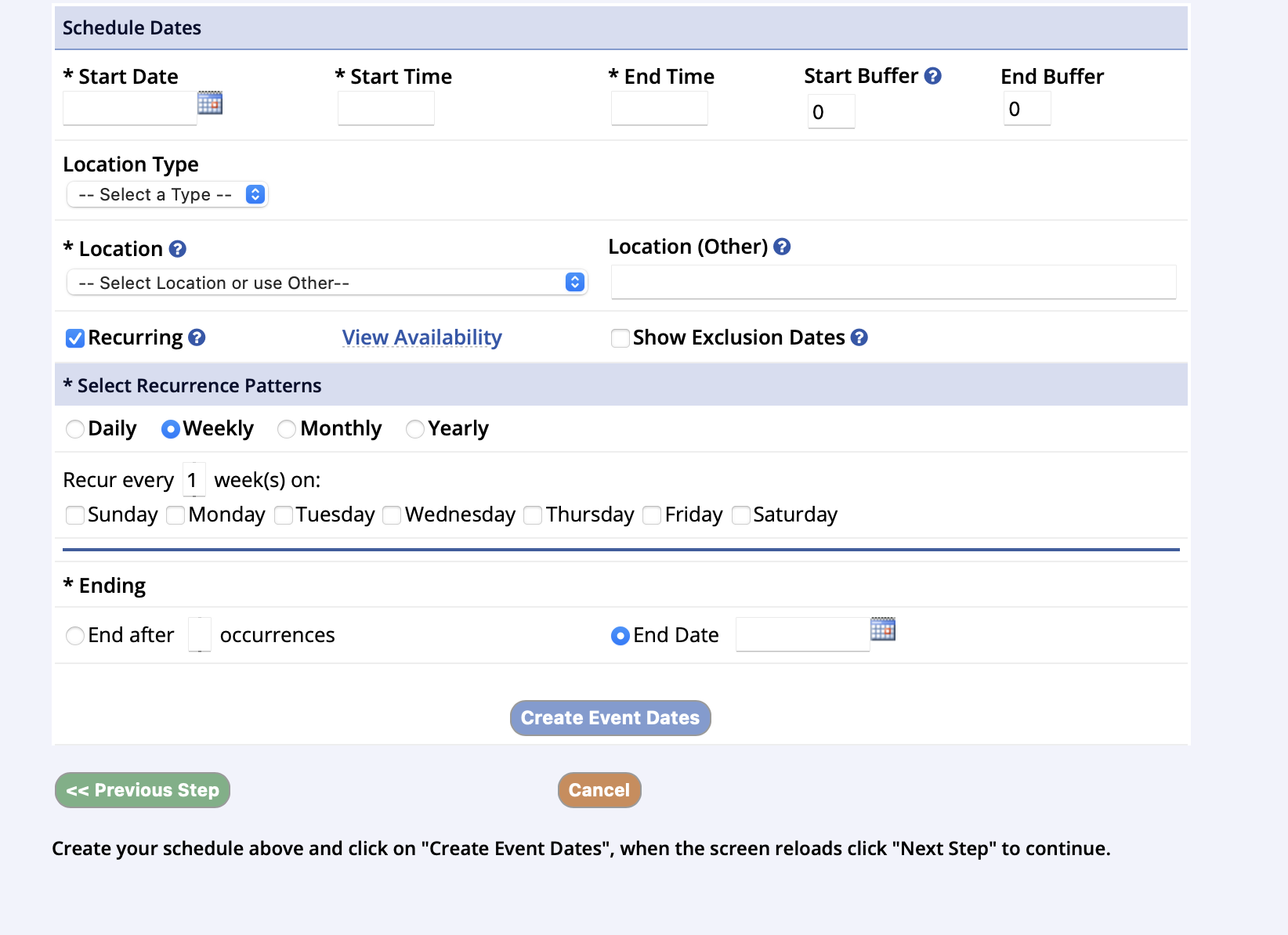
The scheduling screen defines the dates, times and location of the activity. This also creates a booking on the facility calendar.
- To schedule dates, choose the Start Dates, Times, and Location of the activity
- Use Recurring if entering more than one date in a range
- Select the Recurrence Pattern: These define when the activity will take place between the start date and the end by date
- Recurrence patterns are Daily, Weekly, Monthly or Yearly
- If it is not recurring, uncheck the Recurring box
- The Show Exclusion Dates checkbox is used to choose dates that you do not want to have the activity take place
- For example, if that activity falls on a holiday in that schedule
- Choose when the activity will end
- This is required if you're doing a recurring pattern, you can End After X Occurrences or the activity will end after a defined number of occurrences, by choosing End Date
- This defines the final date on which the activity will occur
- Click Create Event Dates
- This may be repeated for additional date patterns
- When all dates are added, click Next Step
Financial Info
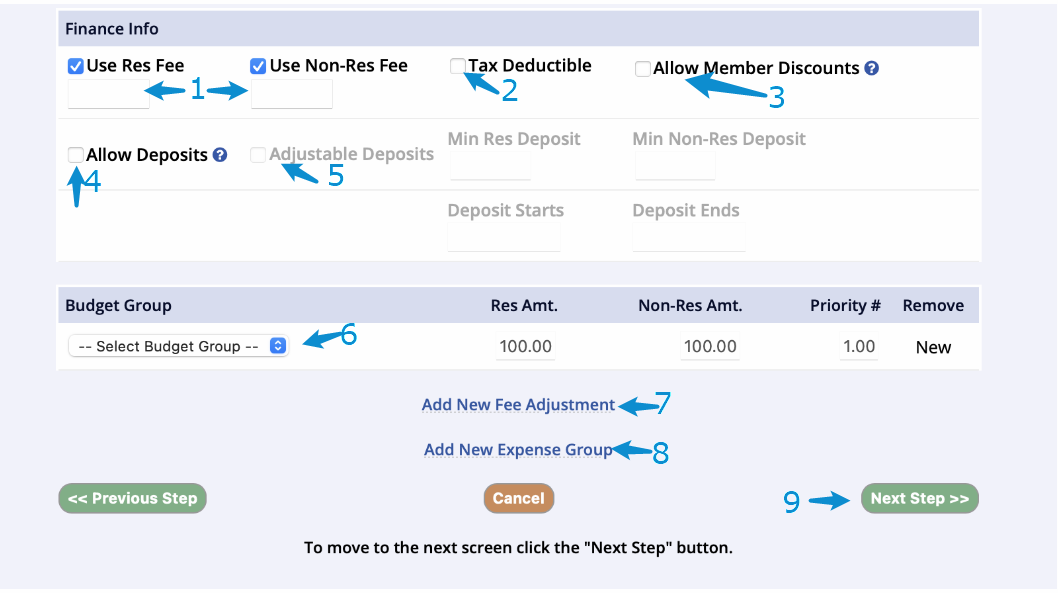
On the financial screen, you will set the fees and the budget group information for the activity.
-
Use Res Fee checkbox is to assign the amount to be charged to residents
-
Use Non-Res Fee checkbox is the amount that is charged to non residents
- If not allowing non-residents to register, uncheck the Use Non-Res Fee checkbox
-
Use Non-Res Fee checkbox is the amount that is charged to non residents
- Checking Tax Deductible lists the activity under the tax deductible section of an Account's finance statement
- Checking Allow Member Discounts will apply defined discounts for individual household account members
- Those discounts are set up on the members account page
- Checking Allow Deposits, allows registrants to pay less than 100% on checkout
- Using Adjustable Deposits allows the users to pay more than the set deposit if deposit is in use
- Next, select the Budget Group and the disbursement amount for resident and non-resident
- Select Percent of Fee for Budget Groups Disbursed by
-
Only if your department has turned on Advanced Disbursements and is dividing the fees into multiple budget groups will you select Fixed Dollar Amount
- An OVERFLOW budget group will need to be selected for amounts in excess of the fixed dollar amount you set when using the Fixed Dollar Amount setting (for late fees, transfer fees, etc…)
- Do not select Fixed Dollar Amount if you are using only one budget group for the fee disbursements due to the way credit card processing fees are calculated outside of MyRec.com within your payment gateway
-
Only if your department has turned on Advanced Disbursements and is dividing the fees into multiple budget groups will you select Fixed Dollar Amount
- Choose from the Budget Group Dropdown
- Enter the percentage (or dollar value) in the fields for Resident and Non-Resident Amount
- If you are selecting a single budget group, the percentage for each field should be 100
- If you have selected multiple budget groups from the dropdowns, you can enter values that total 100% in the columns if you are disbursing by Percentage of Fee, or you can enter values that total the sum of the registration fee if you are disbursing by Fixed Dollar Amount
- Click Submit
- Select Percent of Fee for Budget Groups Disbursed by
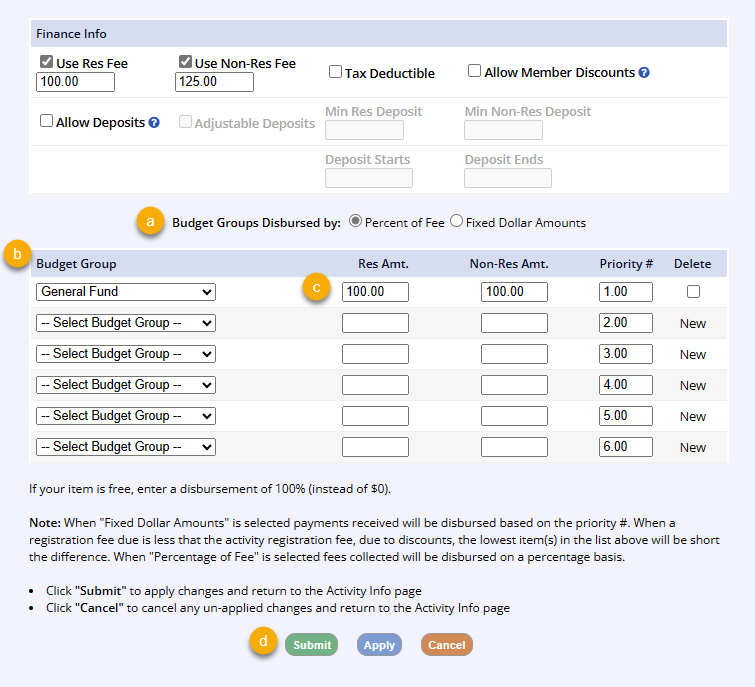
- Click Add New Fee Adjustment to add discounts and/or fees to the activity such as late fees or additional sibling discounts
- Click Add New Expense Group to track expenses related to the activity
- Groups are created under the Finance tab, applied at the item level and reported on by Finance Reports
- Activity level expense: Per Registration type will apply to every registration under this Activity only (percentage or amount); Per Activity will apply to only this activity (amount only)
- When finished, click Next Step
Demographic / Seating Info
Registrant demographic restrictions, waitlist settings, registration type, and registration dates are all set on the Demographic/Seating Info page.
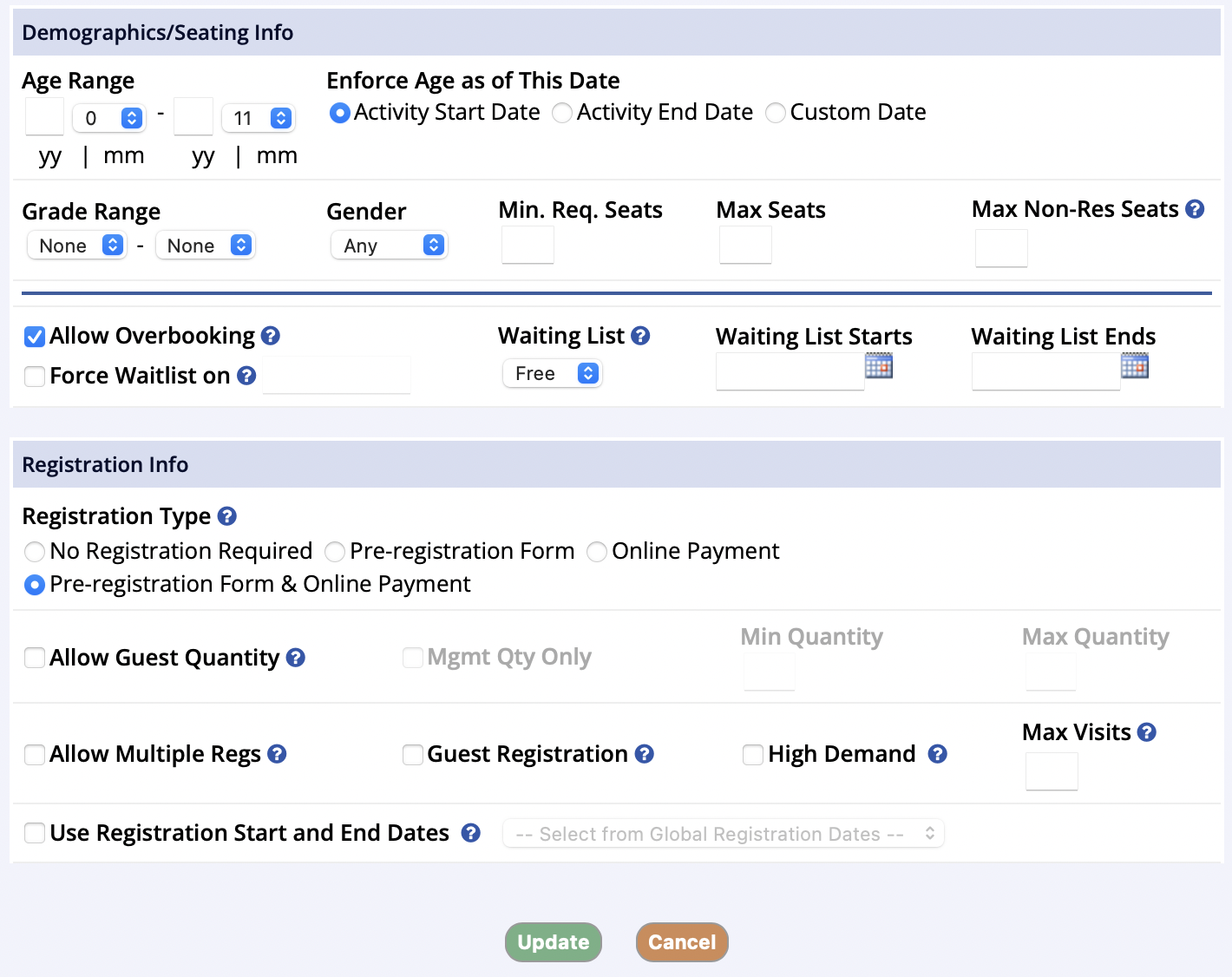
-
Age Range defines the ages that can sign up for this activity
- Enforce Age as of This Date determines the date used by the activity to determine a registrants age for eligibility
- Grade Range defines the grades that can sign up for this activity.
Note:
It is not recommended to use both Age Range and Grade Range settings simultaneously because they can conflict with each other depending on the outlying ages of specific grade-level registrants.
- Gender defines whether this activity is available to males, females or both
- The Minimum Seats Required box is an optional setting that is used to record the amount of people who must sign up for an activity in order for the activity to take place
-
Max Seats box is the maximum amount of people able to sign up for the activity
- Max Non-Res Seats, is the maximum number of non residents who may sign up for the activity, out of the number of Max seats
-
Allow Overbooking allows the office to add more people than the seats of the activity allow
- If waiting list is active, it will take the precedent
-
Waiting list options are free, paid, or none
- This setting will determine whether registrants will go to a waiting list after the activity is full and whether they need to pay to do so
- With Waiting List Starts & Ends Dates, you can define when the waiting list will begin and end
- In the Registration Info box, Registration Type is determined
- Use No Registration Required if it is desired that users not be able to register online or with the form
- Registration Title and Registration Message are required to display instructions to the user
- With the use of the Pre-Registration Form setting, users will only be able to register with a Pre-registration form created for the activity
- This form must be processed by the staff when payment is received
- This does not hold a seat until paid
- Online Payment setting makes it so that users on the public side will then be able to register online with a credit card payment
- Selecting Pre-registration Form & Online Payment, makes it so that public side users can choose to register either online or use a pre-registration form
-
Allow Guest Quantity allows guests of the account to be registered
- Will be disabled if Add Required Membership, Add-ons, or Add Required Activity is in use
- Allow Multiple Registrations allows the same person to register more than once
-
Guest Registration allows the public to register as a guest without creating an account
- Guests registrations do not support waitlists, deposits, or offline payments
- The system will not have any record of the name of the guest for cash payments, so take that into account for refund-likely scenarios
- Please contact a MyRec Client Support Team Member to have this setting turned on
- You will need to have a Guest Account Turned on in addition to turning on this feature function
- Please contact a MyRec Client Support Team Member to have this setting turned on
- High demand setting gives users 15 minutes to reach payment screen during the checkout process
- Using the Registration Start and End Dates determines when registration is available
- It must be defined for both resident and non-resident users and must match the registration type
- You can edit this tab within an activity or by using the Edit All Activities button on the Program screen
- You can extend the registration window by changing the end dates and updating/submitting the settings
Requirements
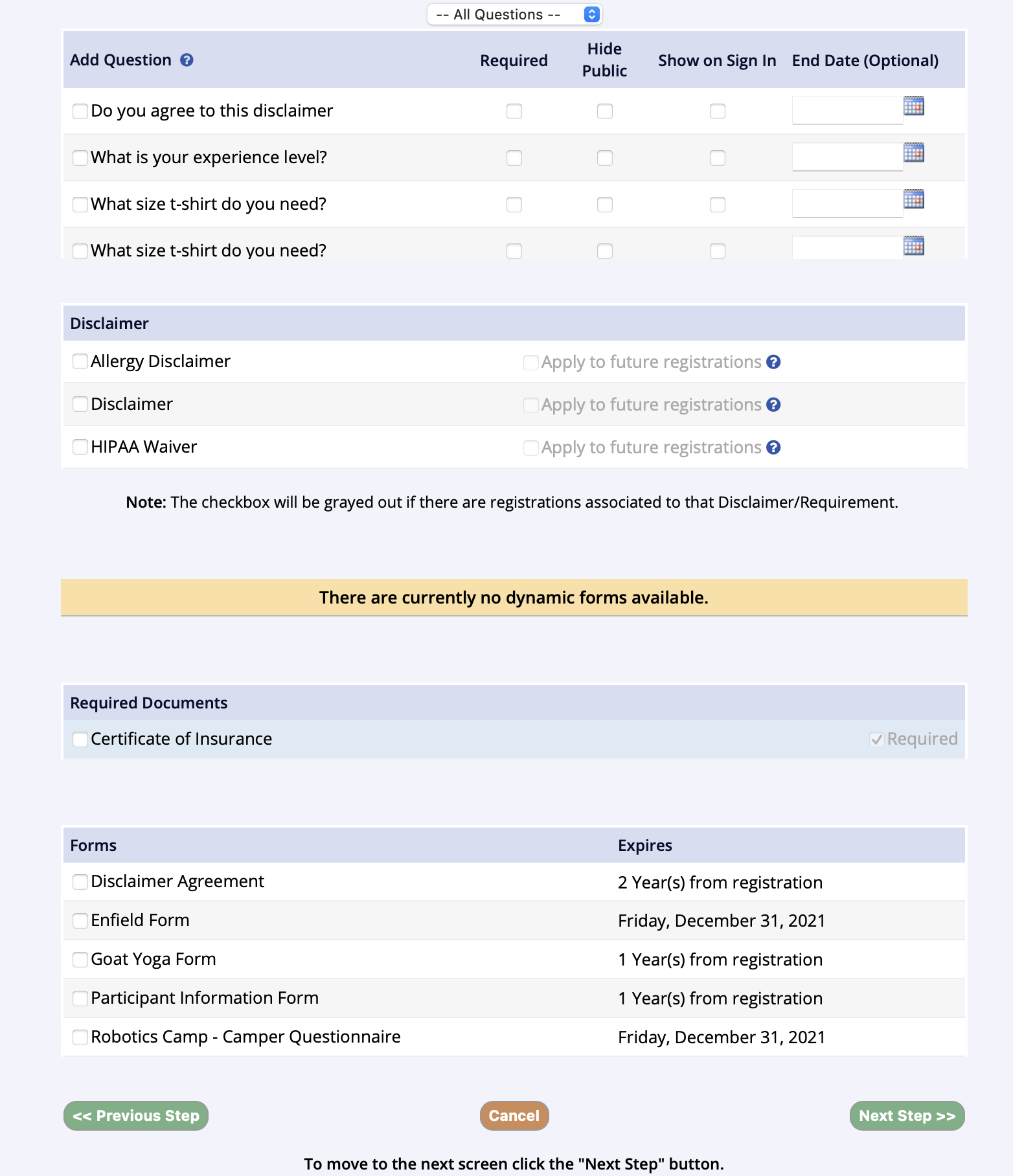
On this step, special requirements can be added to the registration process by using existing questions, disclaimers, custom forms, and required documents.
- Make selections, then click Next Step.
Confirm & Complete
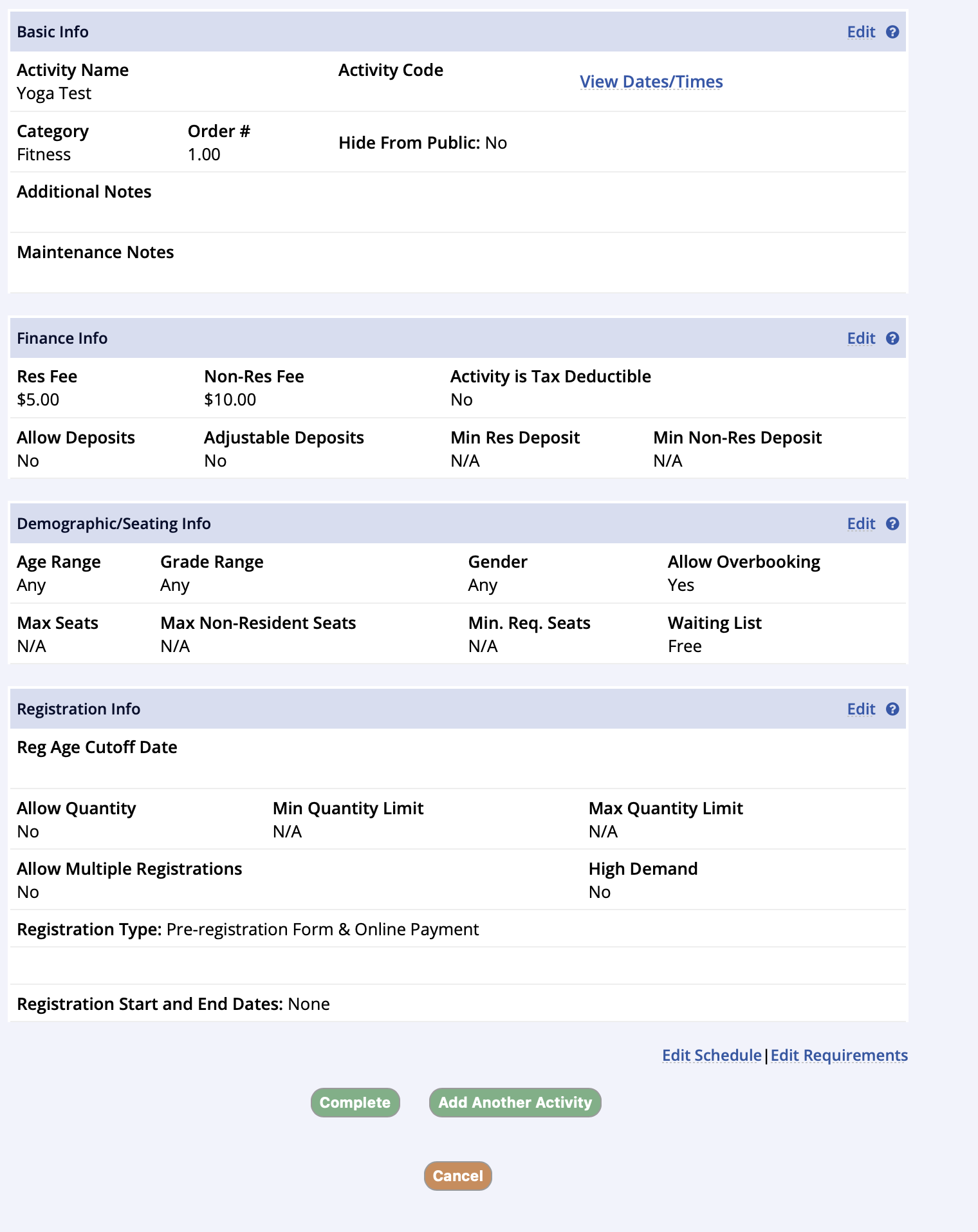
On this last screen, we can click to Complete to finish our activity creation or click Add Another Activity to create a new activity using the existing data. This option saves time by bringing over all fields pre-filled with data you had just entered. All you need to do is change info where needed.
Standard Activity Video
...
Standard activities are the simplest way to set up registration for your customers. They offer a single fee structure per activity and have the benefit of a waitlist feature. You can also set up teams and keep scores in Standard Activities.
Advanced Activity Creation
Advanced Activities Video
...
This video will help you learn more about Advanced Activities within the Programs feature of MyRec.com
Creating an Advanced Activity
Because Programs house activities, they must be created first in order to add activities. See Program Creation article for more details.
- On the management side, go to the Programs tab in the lefthand navigation, then click Add New Program
- Enter information as needed
- Make sure to select Advanced Activity as program type
- Click Next
- This will take you to the program screen
- Click the Add Activity button on the upper right
Basic Info

- Name the Activity
- We suggest entering something recognizable by the activity name only, as this it what appears on the calendar
- The Activity Code field is used if your department assigns codes to activities. Activities can be searched on the code for registration
- The Activity Order number shows the order in which the activities are organized on the site, the lower the number, the higher on the list the activity will appear
- Select a Category from the dropdown or add a new one
- A category is the section this activity will be filed under when viewing all activities from the public side
- Activity Notes is a place to enter additional need to know information. This information shows under the activity for the public
- If Receipt Notes are entered, they will appear on the printable and emailed receipt upon the completion of the registration
- Maintenance Notes is a place to enter any setup or staff details that will appear on the facility maintenance report
-
Date to Show on Public Site defines the date this activity is visible to the public
- If it is blank, it will appear immediately
- If the second field is blank, the activity will drop off the public side after the last activity date
- When Hide This Activity From Public is checked, the public will not be able to view this activity
- When Hide This Activity from Management is checked, the activity will not appear in the activity search results for management side registration
- Note that these will be unchecked by default upon creation
- When Hide Activity from Calendar if checked, the activity will not populate the management calendar
- This is useful for activities like swim lessons that would fill your staff's calendar view
- Click View/Add Coaches & Instructors to give access to rosters for this activity, which are viewable on their public side accounts
- Checking Allow Member Discounts will apply defined discounts for individual household account members. Those discounts are set up on the members account page
- If this activity will have time slots, check the box Register by Time Slot
- Checking the Show Add-On Products box allows activity to suggest/require purchase of products during checkout
- Click Next Step to move on to create a schedule
Schedule Dates
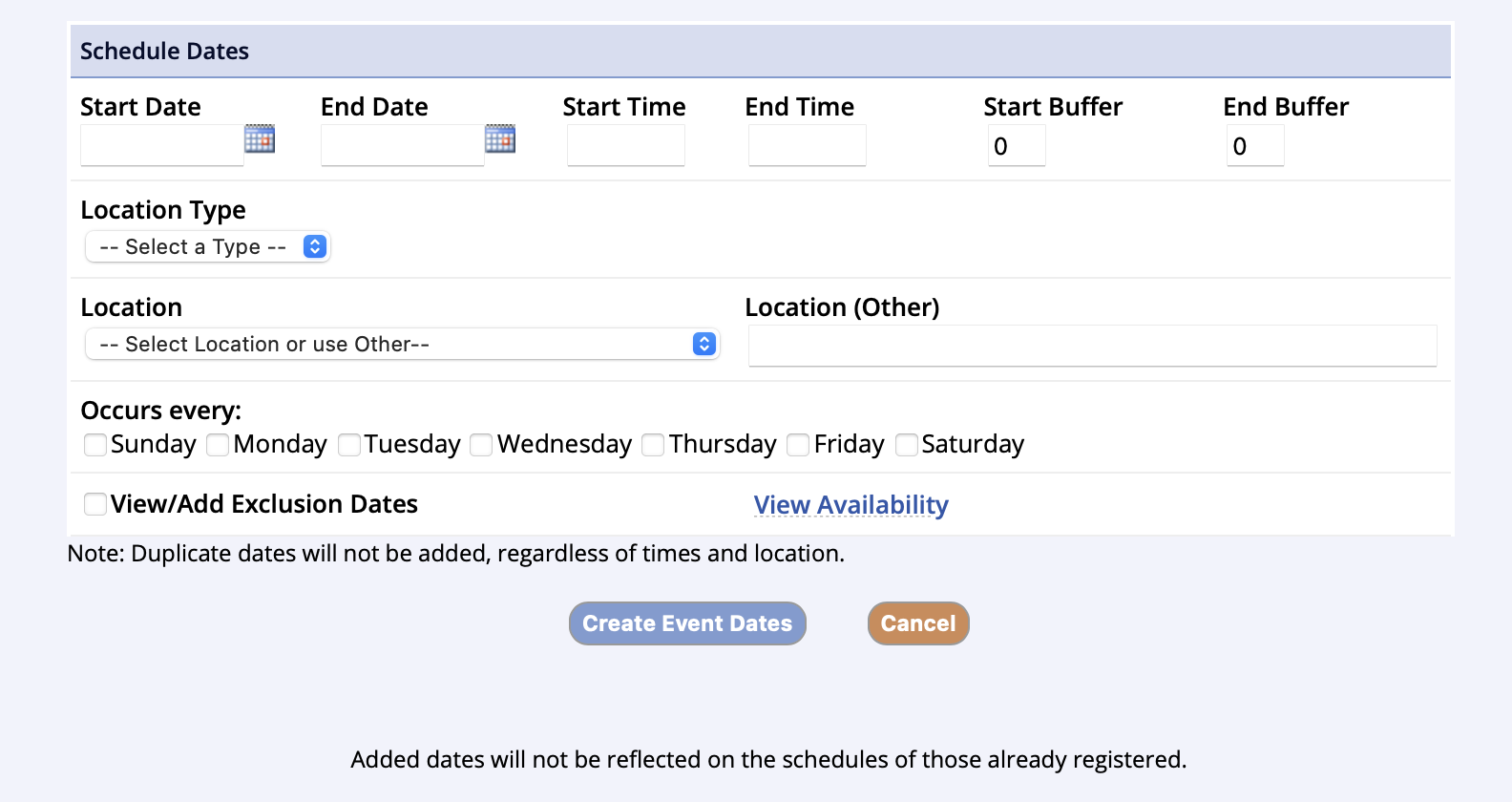
The scheduling screen defines the dates, times and location of the activity. This also creates a booking on the facility calendar.
- To schedule dates, choose the Start Date and End Date, Time and Location of the activity
- Check boxes for the day(s) of the week the activity occurs
- Use the View/Add Exclusion Dates checkbox to choose dates that you do not want to have the activity take place
- For example, if that activity falls on a holiday in that schedule
- If you wish to reduce the fee for pricing options that include an Exclusion Date, you will need to add the Missed Day Credit for residents and/or non-residents in the pricing option screen
- For example, if that activity falls on a holiday in that schedule
- Click Create Event Dates
This may be repeated for additional date/time patterns.
- When all dates are added, click Save Info
- Confirm the list of dates, edit, exclude or delete as necessary, then click the Add Pricing Options button (lower right of screen)
Pricing Options

- On the Pricing Option popup box, click the dropdown Choose a Pricing Matrix and select the option that works best for your activity
-
Single Day allows purchase of individual days in a session
- Ex: September 1st, October 31st, and December 7th
-
Weekly allows purchase of individual weeks in a session
- Ex: Week 1 (Sept 1st - 7th) and Week 3 (Sept 14th - 21st)
- Using Min and Max Fixed rate Days allows customers to choose which days of the week they would like to register for during that week
- For example, if 1 to 1 is used, a customer could select only Monday for the week(s) selected) or if 3 to 5 is used, they could do MWF of M-F for the week(s) selected
-
Monthly allows purchase of individual months in a session. ex: Month 2 (October) and Month 4 (December)
- Using Min and Max Fixed rate Days allows customers to choose which days of the week they would like to register for during that month
- For example, if 1 to 1 is used, a customer could select every Monday for the Month(s) selected) or if 3 to 5 is used, they could do every MWF of M-F for the month(s) selected
- Choosing the days of the week allowed to be registered for allows customers to only register for the days you have available
- Using Min and Max Fixed rate Days allows customers to choose which days of the week they would like to register for during that month
-
Entire Session allows purchase every day in a session
- Ex. All Days would allow the customer to attend all activity dates just like any standard activity
- Session Dates - if you use an Entire Session pricing option, you can set a range for which weeks of the activity that fee covers Example: If you have three sessions of swimming lessons available, and each session is two weeks in length, you can set up three “entire session” pricing options that would each be set to the appropriate two-week interval. You would title each pricing option Session 1, Session 2, etc…
- Ex. All Days would allow the customer to attend all activity dates just like any standard activity
-
Single Day allows purchase of individual days in a session
- Once an option is chosen, the screen will reload
- After it does, click Add
- On the screen that loads, fill out the fee information, description, and any other applicable information
- Change the name of the option to better inform the public of the option
- For example, the default name might be “Multi Days”, but you can change that to something like MWF Entire Session
- Keep the description brief so it is more easily read
- Change the name of the option to better inform the public of the option
- There are other options you may choose to use, depending on the type of pricing option you choose
- Certain options may not be used together such as recurring payments and deposits
- These options will either disallow selection when not available or have notes explaining the conflict
- Allow Deposits allows the registrant to pay only part of the cost at time of purchase
- Standard Deposit requires a deposit of a set figure on purchase
- First Week/Month Deposit requires a deposit in the amount of the first week/month
- Last/Week/Month Deposit requires a deposit in the amount of the last week/month
- First & Last Week/Month Deposit requires a deposit for both first and last week/month
- Adjustable Deposits allows the registrant to pay more than the set deposit amount
- Repeating Deposits sets the deposit on each time block rather than only on the first
- Fixed Rate Days per Week sets the minimum days that must be registered for per week
-
Missed Day Credit reduces the cost of a block of time when there is an exclusion date
- Use this in combination with adding an exclusion date to the schedule to reduce the fee of a pricing option that has dates including an exclusion date
- Just add the exclusion date alone will not impact the fee, just the schedule
- Use this in combination with adding an exclusion date to the schedule to reduce the fee of a pricing option that has dates including an exclusion date
- Min/Max Weeks/Months requires a min/max number of weeks or months in a purchase
- Registration Deadline disallows registration a set number of days before it occurs
- Automatic Recurring Payments* charges the customer automatically for each week/month
- Show on Site Date sets dates that the pricing option hides and shows on the public site
- Require Remaining Weeks auto-selects all remaining Weeks for registration (required for public, suggested for staff)
5. Click Next Step when finished
6. Select Add another option to add more options to this activity or No, I am finished to continue setup
7. Select the Budget Group assignment(s)
8. Click Next Step
*Automatic Recurring Payments requires that Authorize.net is being used as your merchant gateway. Additionally, administrative settings must be activated in order for this option to be used. Contact a MyRec.com Representative for more information.
Registration Info
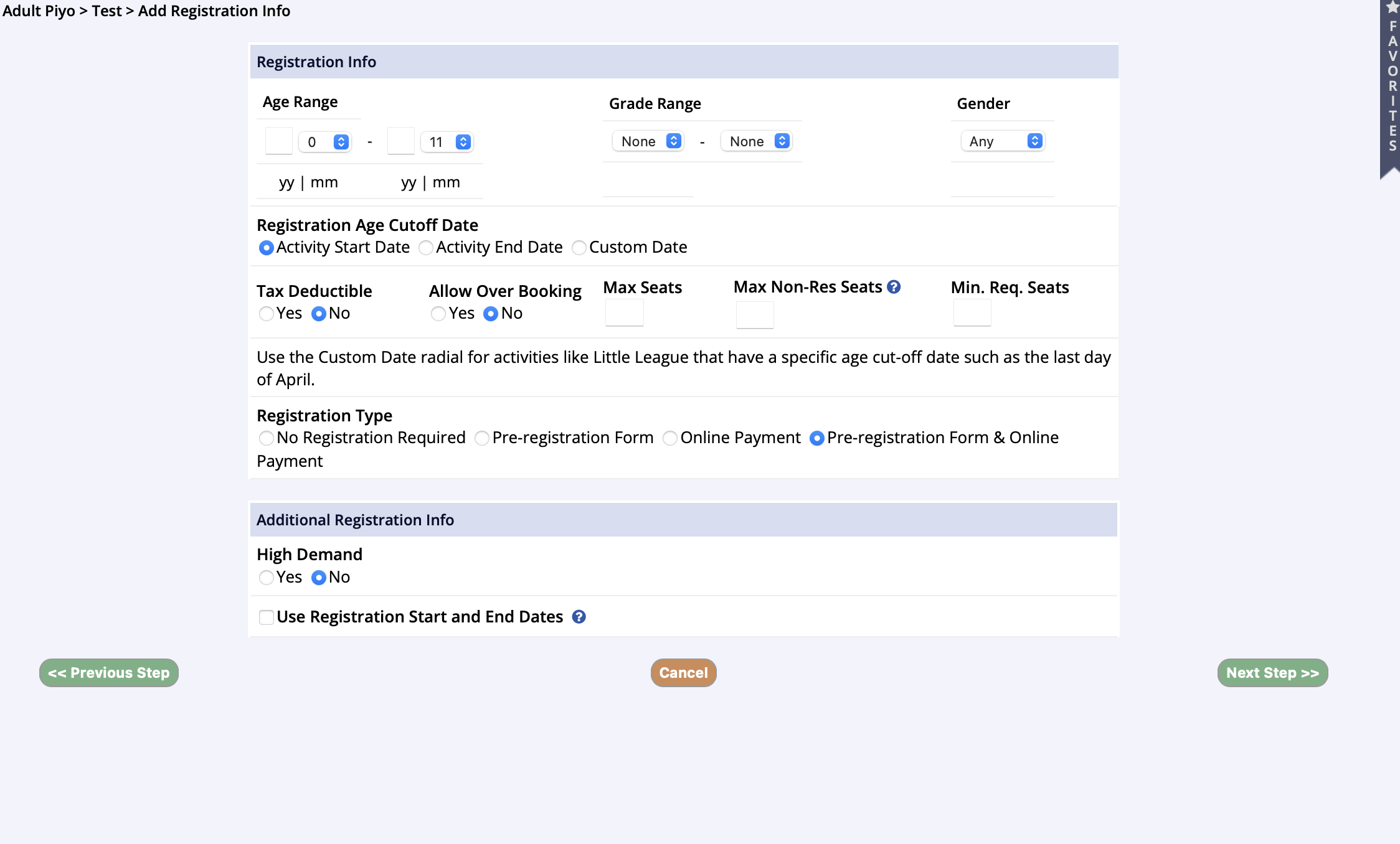
- Make selections for Registrant restrictions
-
Age Range defines the ages that can sign up for this activity
- Registration Age Cutoff Date determines the date used by the activity to determine a registrants age for eligibility
- Grade Range defines the grades that can sign up for this activity
- Assigning an Age Range and Grade Range simultaneously may result in confusion with certain age and grade combinations depending on your community
- Be aware of this with Pre-K activities, for instance, where you can have 3, 4, 5, and 6 years olds in Pre-K, so you will be excluding the Pre-K 3 and 4 year olds if you set the age to 5 and the grade to Pre-K
-
Gender defines whether this activity is available to males, females, or both
- If you have added a Custom Gender in your admin settings, choosing Male or Female in this dropdown will exclude the Custom Gender from registration
- To include the Custom Gender registrants, you will need to set this to Any in the dropdown
- If you have added a Custom Gender in your admin settings, choosing Male or Female in this dropdown will exclude the Custom Gender from registration
-
Age Range defines the ages that can sign up for this activity
- Checking Tax Deductible lists the activity under the tax deductible section of an Account's finance statement
- Allow Overbooking allows the office to add more people than the seats of the activity allow
- Max Seats is the maximum amount of people able to sign up for the activity per day
- Max Non-Res Seats is the maximum number of non residents who may sign up for the activity per day, out of the number of Max seats
- The Minimum Seats Required box is an optional setting that is used to record the amount of people who must sign up for an activity in order for the activity to take place
- In the Registration Info box, Registration Type is determined
- Use No Registration Required if attendees for this activity do not need to register online or with the form
- Registration Title and Registration Message are required to display instructions to the user
- Using Pre-Registration Form as the Registration Type will only allow users to process a Pre-registration form created for the activity not actually register at this time
- This does not hold a seat until the invoice has been paid and processed by the staff
- This form must be processed by the staff when payment is received
- Selecting Online Payment makes it so that users on the public side will then be able to register online using a credit card payment
- Selecting Pre-registration Form & Online Payment makes it so that public side users can choose to register either online or use a pre-registration form
- Again, any registrants who choose the Pre-registration Form option will not be registered or holding a seat for the activity until payment is applied by staff
- Use No Registration Required if attendees for this activity do not need to register online or with the form
- Checking High Demand gives users approximately 15 minutes to reach payment screen during the checkout process
- This is helpful to avoid Cart Holds and the Waiting List beginning while people sit on their registration decision
- Enter the Registration Start and End Dates, which determines when registration is available and automates the start and end of registration so the staff does not have to remember to open and close it
- It must be defined for both resident and non-resident users and must match the registration type
Using the Hide Feature Instead of Start/End Dates?
Hiding a program or activity from the public does not have the same effect as using Registration Start and End Dates. If a customer has bookmarked the activity page and you are not using an End Date for registration, the participant can register for that activity even after you've hidden it (if seats are available) because they have the direct link. Using the Registration Start and End dates effectively opens and closes registrations automatically at the time and date you select to avoid having this issue.
- It must be defined for both resident and non-resident users and must match the registration type
Requirements
On this step, special requirements can be added to the registration process by using existing questions, disclaimers, custom forms and required documents.
- Make selections and then click Next Save and Review
- If the question, disclaimer, or custom form does not yet exist, you will need to create it
- Right click Questions/Disclaimer/Custom Forms from the leftside navigation bar and Open in New Window
- Create the Questions/Disclaimer/Custom Form and click the button at the bottom to save/add/update
- Return to the screen where you are creating the advanced activty and refresh to see newly created item
- If the question, disclaimer, or custom form does not yet exist, you will need to create it
Add Required Documents
Add Required Documents
Access the Required Documents
- Open the Administration tab on the leftside navigation menu
- Select the Settings option
- Click the Account Settings tabs
- Scroll to the bottom of the page and click the Add Required Documents link
- Required Documents can be added to Accounts, to Activities, or to Memberships and are stored in the member's information page
- Only users who are listed as Administrators are able to Add Required Documents
- You will be prompted to fill in the Add Activity Required Documents where you can enter the name of the Required Document, add a Description, attach an optional Document, and Hide from Public
- Required Documents that have attached documents will show up as a hyperlink; required documents without attached documents will not be hyperlinked
- Prior to clicking Submit, you are notified to ‘Please keep in mind that this is not currently a HIPPA-compliant system and that requiring the upload of sensitive information is not recommended’
Hide From Public and Upload Document
If you choose to hide the Required Document from the public, the document will be listed on the Member Info page only on the management side.
Staff will be able to upload the Required Document and set an Expiration Date.
- Once the Required Document has been created, click the Submit button
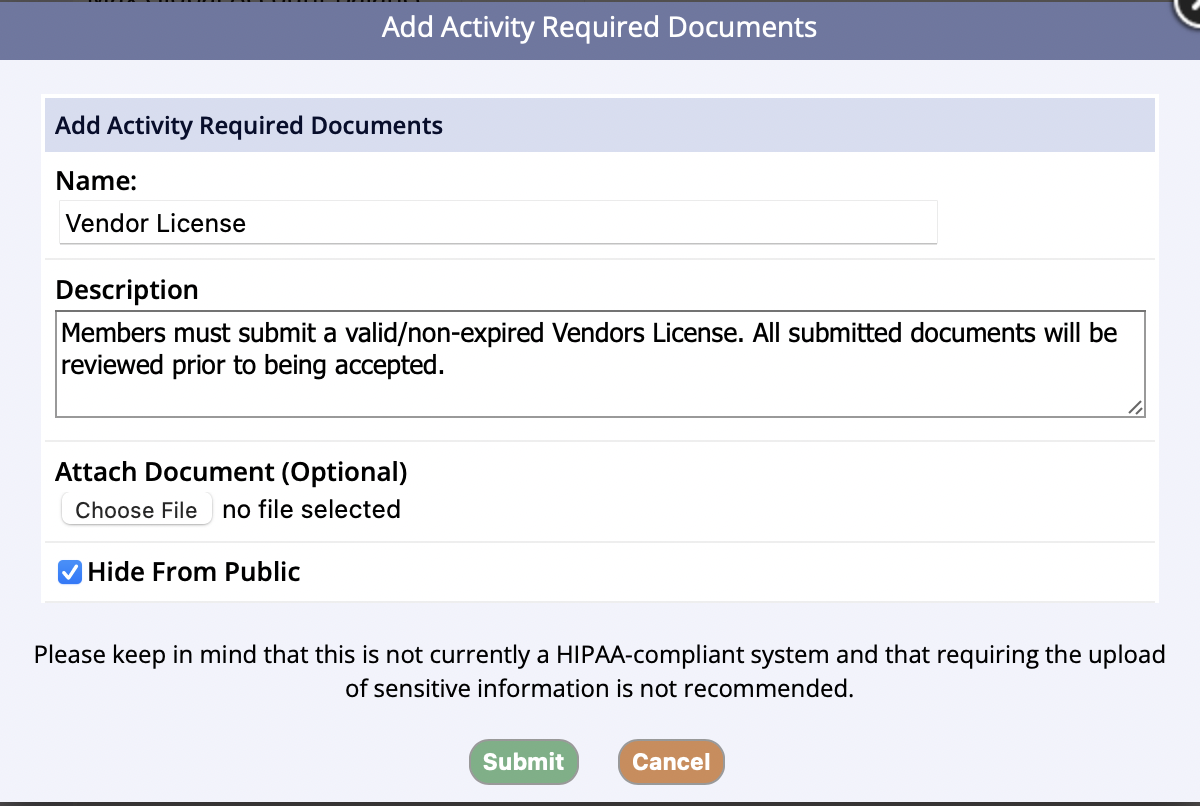
Account Required Document
- If Required Documents aren't hidden from the public, members are able to Upload Required Documents from the Account Member page on the public side
- When the member uploads the document it, will be listed as pending until the staff decides to Approve, Decline, or Delete the upload
- At the time of determining the status of the uploaded document, edits can be made

Require Proof of Residency

In the Account Settings tab of the Administration Setting screen, you can find the account Proof of Residency setting. This can be applied at the account or at the member level.
This is intended to be used in conjunction with the Pending Approval Account/Member process, but if you do not use the pending account approval process, your staff will need to manually review the uploaded image and then update the residency status manually within the account. If you are using this with the pending approval process, your staff will review the upload when the account/member is approved/declined.
Declining an account will also delete any required residency document uploads.
To access the Proof of Residency Required Documents, on the Account level, navigate to the homepage for the household. The document will be located just above the Account Details section.
To access the Proof of Residency Required Documents, on the Member level, navigate to the member page. The document will be located all the way at the bottom of the Member Info screen in the Member Proof of Residency documentation.
Activity Required Document
Overview:
- You are able to Add Required Documents to Activities
- If the Required Document is hidden from the public, and it is marked as Required for an Activity, it will be required to Upload from the public side during the activity registration
- If the Required Document is submitted during an activity registration from the management side, the staff will be prompted to enter an Expiration Date
To Add a Required Document to an Activity:
- Go to Programs
- Click View/Search Programs
- Select the Program, locate the Activity that needs to have the Required Document
- Once in the selected Activity, click on the Requirements tab
- Click the Add/Edit Required Document link

- Here, you have the option to select which Required Document to add to the activity
- It's optional to make the document Required
- If you uncheck Required for Management, then when a staff member completes a management registration, the document will be optional upon checkout
- The staff can let the user know to upload the document from their public-side account
- If you uncheck Required for Management, then when a staff member completes a management registration, the document will be optional upon checkout
- It's optional to make the document Required
- Click Update
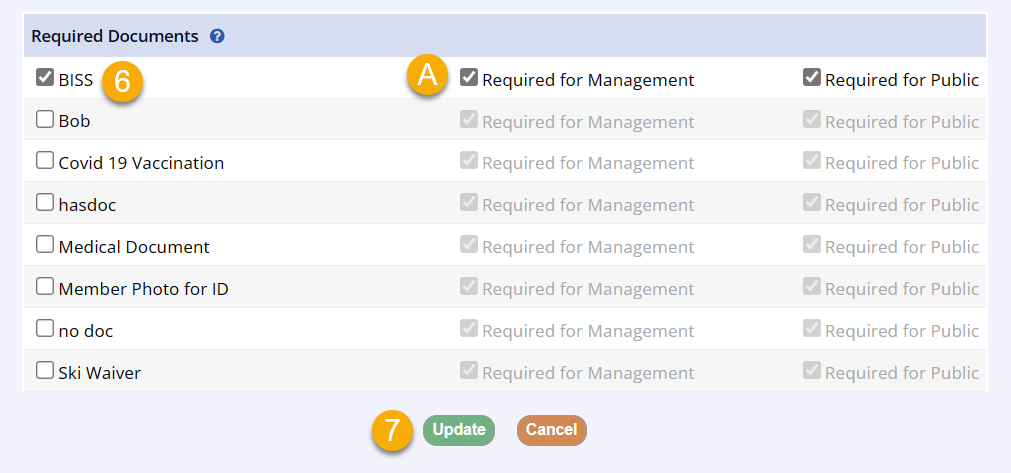
Membership Required Document
Overview:
- You are able to Add Required Documents to Memberships
- If the Required Document is hidden from the public, and it is marked as Required for a Membership, it will be required to Upload from the public side during the membership registration
- If the Required Document is submitted during a membership registration from the management side, the staff will be prompted to enter an Expiration Date
To Add a Required Document to a Membership:
- Go to Memberships
- Click View Memberships
- Select the Membership where you want to add a Required Document
- Once in the selected Membership, click on the Requirements tab
- Click the Add/Edit Document Requirements link

- Here, you have the option to select which Required Document to add to the activity
- It's optional to make the document Required
- If you uncheck Required for Management, then when a staff member completes a management registration, the document will be optional upon checkout
- The staff can let the user know to upload the document from their public-side account
- If you uncheck Required for Management, then when a staff member completes a management registration, the document will be optional upon checkout
- It's optional to make the document Required
- Click Update
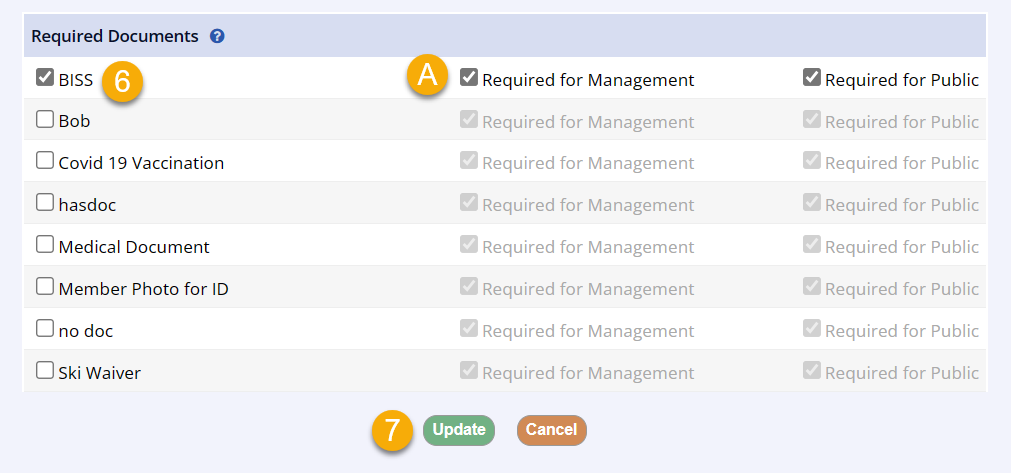
Facility Required Document

- Go to the Requirements tab for the facility or facility area
- Click Add/Edit Document Requirements
- Check the boxes for any documents you want to required on the reservation for that facility
- Use the checkboxes to require or not require the selected documents
- Click Update
Reports
Required Documents Report
Overview This report is for those activities (also available for Memberships) tha
Overview
This report is for activities, memberships and accounts that have Required Documents. When the activity / membership is selected, the results show the registrants with the required document name, date stamp of submission and update, as well as status. Results can be filtered by document, by status, and by type.
When the account is selected, results can be filtered from an expiration date range, document, and by status. You have the option to filter the report to show submissions by no expiration date or to view the summary and filter by status.
Document Status
There are many document statuses for Required Documents:
- Active (by Account only): Document has been uploaded and is in the members account
- Approved: Document has been uploaded via management or management has approved document uploaded by customer
- Declined: Document has been uploaded but declined by management
- Expiring Soon (by Account only): Document had been uploaded and an expiration date was determined upon approval and is going to expire soon
- Expired: Document had been uploaded and an expiration date was determined upon approval and it is now past
- Missing: Document is required for the activity but is not uploaded in the account
- Pending: Document has been uploaded via the public side and is awaiting management approval
Required Documents by Activity
- Go to Reports > Activity Reports > Select Required Documents in the Activity Reports section
- Select the activity name for the documents status you would like to check
- Filter by Document, Status, and/or Type
- Click the Submit button
- This report includes the:
- Account
- Member Name
- Document
- Submitted
- Status Update
- Status
- Required
- Expiration Date
Clicking the members name will bring you to the View Member Info page for that member within their account. This is where the document can be updated.

Required Documents by Membership
- Go to Reports > Membership Reports > Select Required Documents in the Requirements section > Select the membership name
- Filter by Document, Status and/or the date range when the Membership Expires Between
- This report is able to be filtered to Include memberships with no expiration dates
- Click the Submit button
- This report includes the:
- Account
- Member Name
- Document
- Submitted
- Status Update
- Status
- Required
- Expiration Date
Clicking the members name will bring you to the View Member Info page for that member within their account. This is where the document can be updated
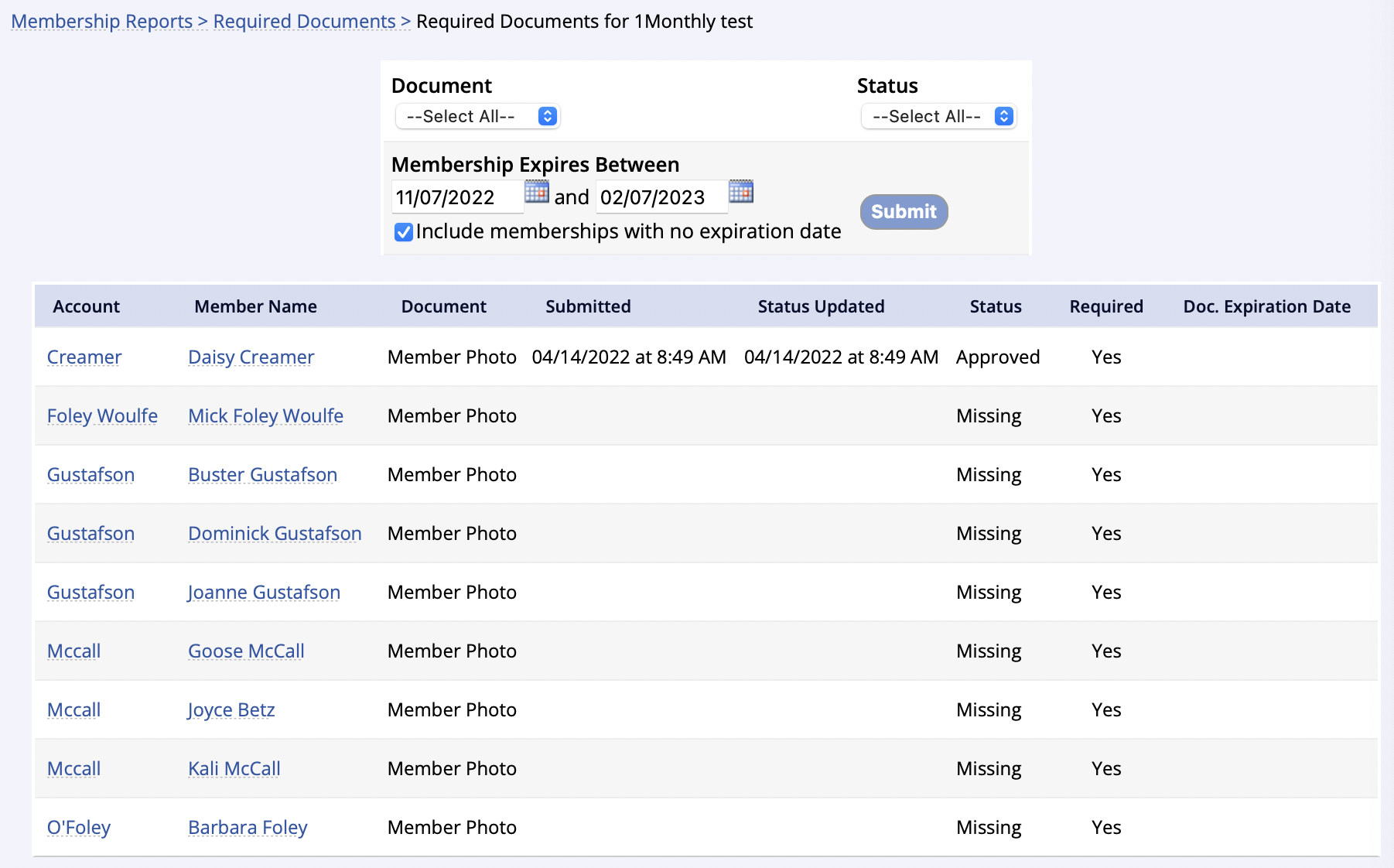
Required Documents by Account
- Go to Reports > Account Reports > Select the Required Documents in the Account Requirements section
- Filter the date range when the membership Expires From-To, Document and/or by Status
- This report is able to be filtered by No Expiration Date Only
- Click the Submit button
- This report includes the:
- Account
- Member Name
- Document
- Submitted
- Status Update
- Status
- Required
- Expiration Date
Clicking the Member Name will bring you to the View Member Info page of that member within their account. This is where the document can be updated.
- Users are able to select:
- View Summary: gives the user the option to view the required documents by account and the option to filter by Status
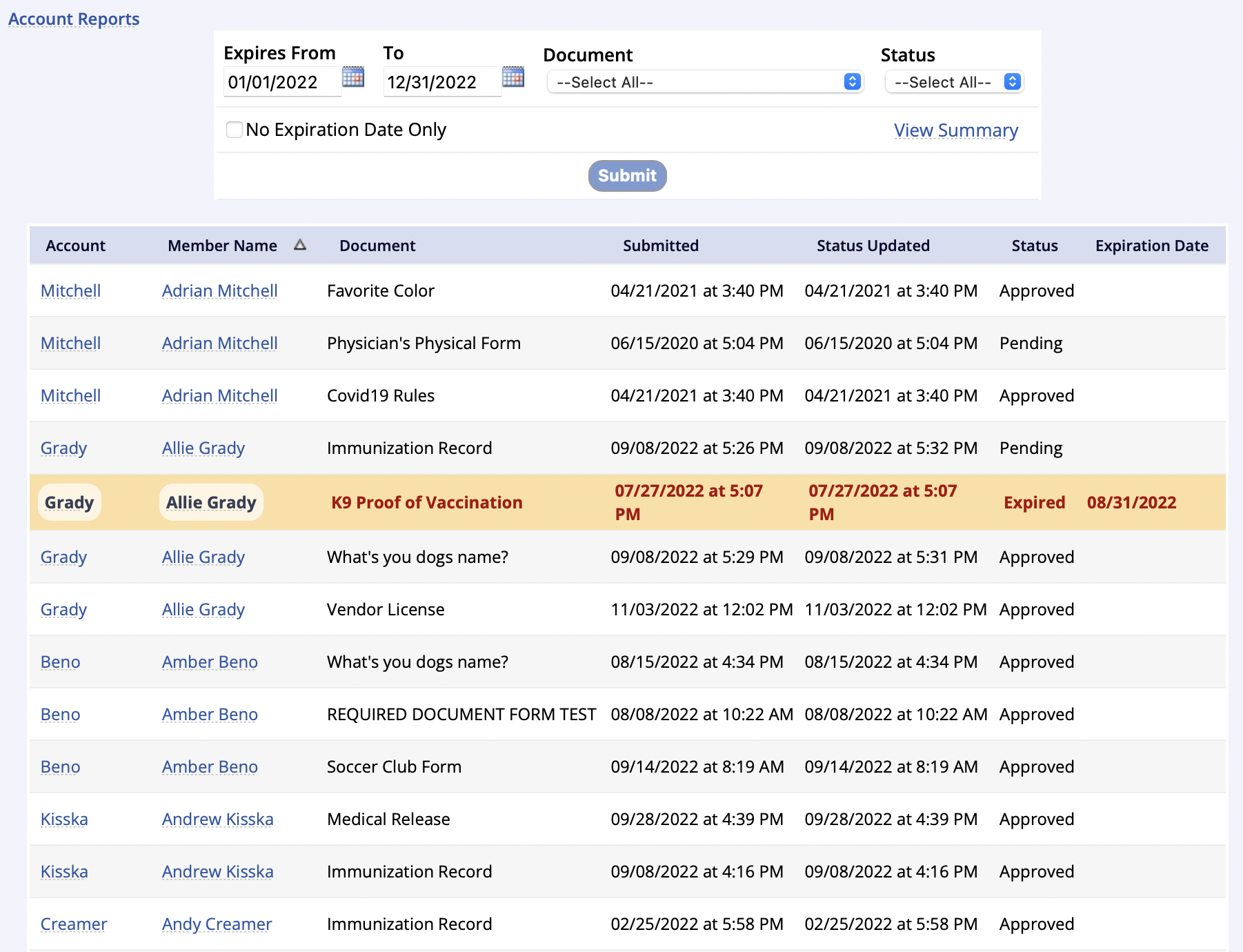
View Summary Report
Selecting View Summary will allow the user to view the required documents by account and the option to view by their Status
- This report includes the:
- View, the submitted required document
- Registrant
- Document Name
- Expiration Date
- Status
- Clicking the View link will allow you to View Attached File, Edit, Approve, Decline or Delete the submitted document
- This filtered report is able to be exported
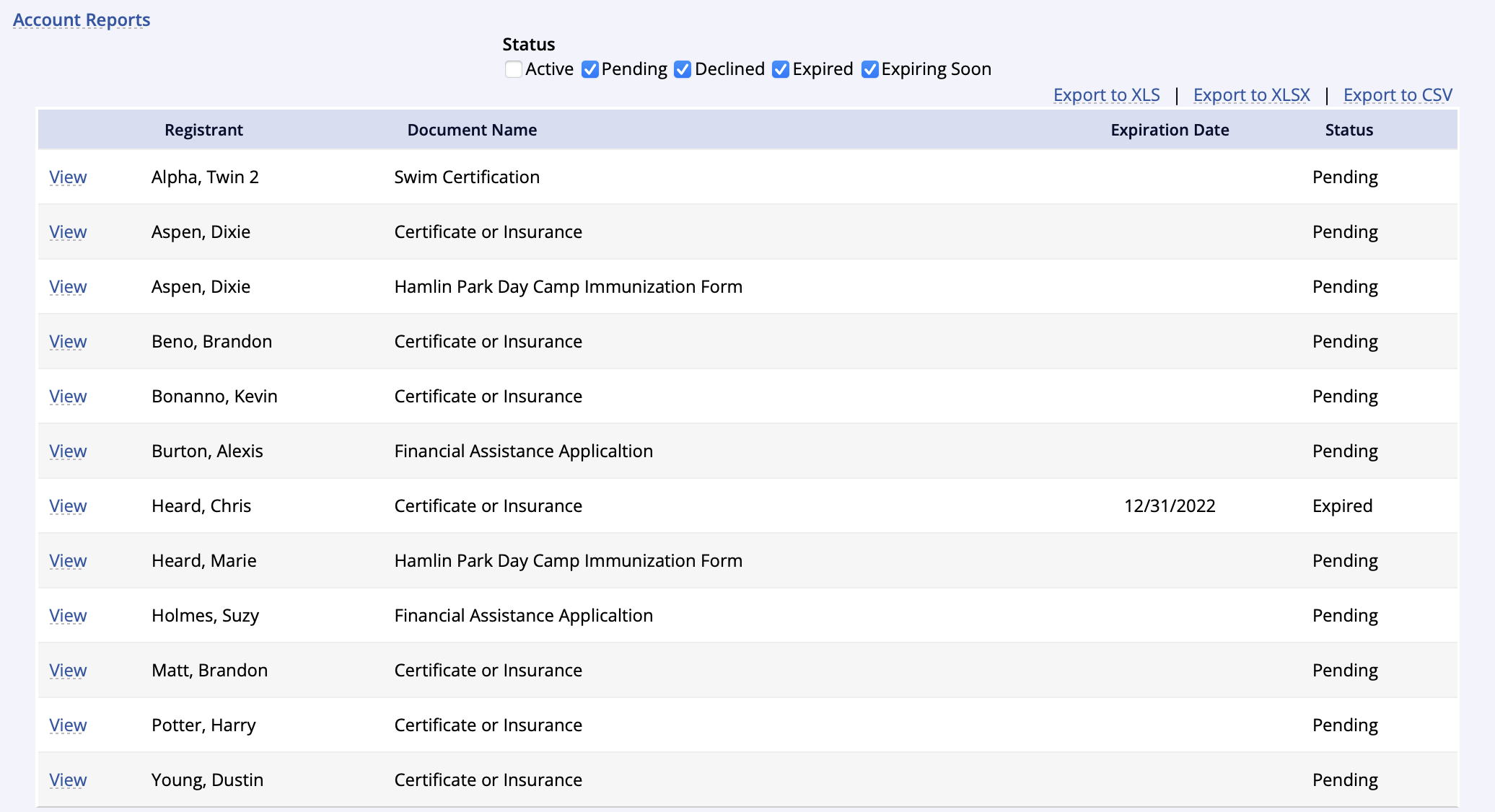
Reminders
The Required Document will not be listed on the Account Member page on the public side.
If the Required Document isn't hidden from the public, the member is able to upload the document, which will be listed as Pending until the staff approves the document.